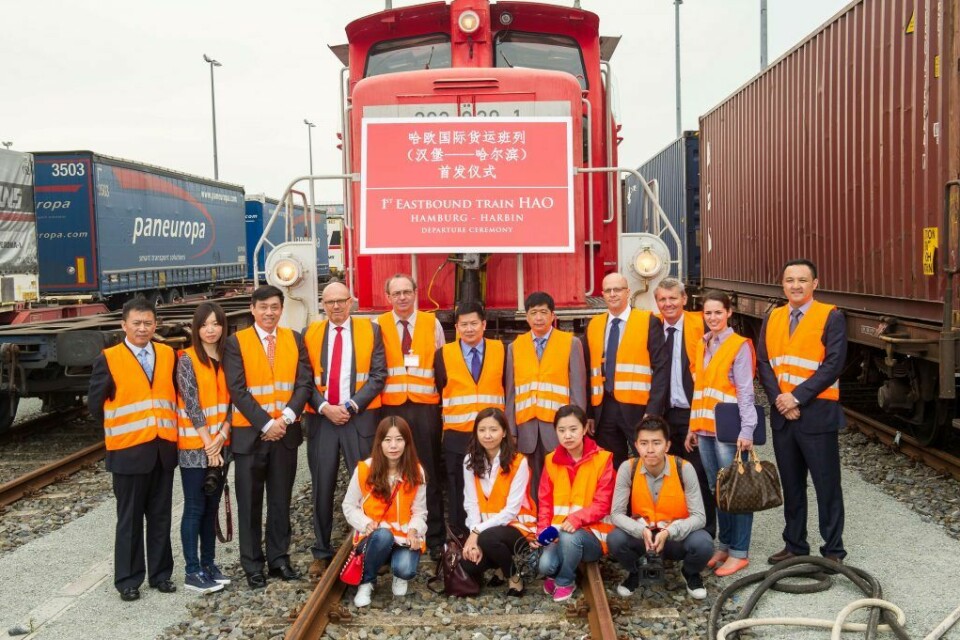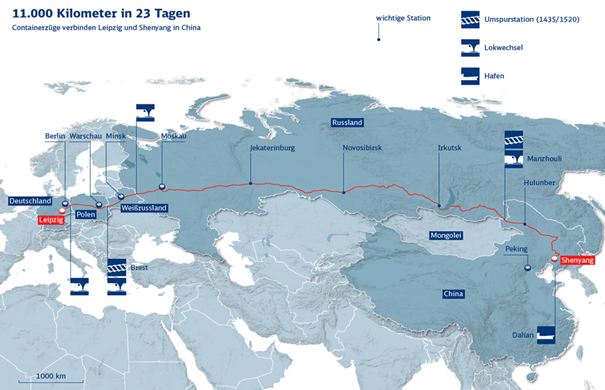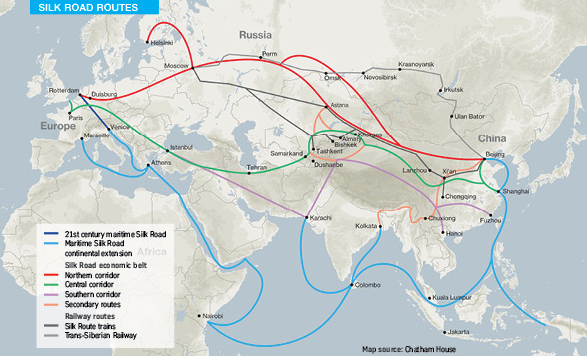China-Europe rail: The road less travelled
The old Silk Road that connected China to Europe rose to significant prominence during the seventh and eighth centuries, when not only was silk moved from China but also spices, paper and noodles across Eurasia. The route has been disrupted and dismantled many times during the last millennium or more, not least in recent times by the sharp rise in container shipping during the last century.
However, the Silk Road lives on, at least in policy and imagination, if not in hard trade. Over the past few years, the Chinese government has spoken ambitiously about its ‘One Belt, One Road’ initiative, a plan to revitalise and modernise trade and connections across dozens of countries and multiple continents. Some $40 billion worth of investment has been discussed as part of a sweeping range of programmes that includes maritime and intermodal routes across China, South-east Asia, Russia, central Asia, the Middle East, Africa and Europe.
Long-distance rail across the Eurasian landmass, though only one part of this vision, is important to the government’s hopes. It is also a service that has already gained prominence and use in the automotive sector, with rising interest in moving both car parts and vehicles by rail. Although overall volumes are still relatively small, and tend to be part of niche flows, there is potential for expansion across these and other routes.
While automotive trials have been taking place in connecting China and Europe by rail for at least a decade, over the past two years a number of new rail links have been established between automotive production and assembly plants in Europe and China. Gefco, in partnership with its majority shareholder Russian Railways, has been offering a number of services across the Trans-Siberian Railway, as well as to western China and across central Asia. Another example is UTi Worldwide (recently acquired by Denmark’s DSV), which has partnered with China’s Beijing Changjiu Logistics to offer an ‘Iron Silk Road’ service between Harbin, in north-east China, and Hamburg, Germany. Other examples include the Trans-Eurasia Logistics link between Chongqing and Duisburg, Germany and the Chengdu-Europe Express Rail link.
One of the first companies to get involved in rail transport between Europe and China, particularly for the automotive sector, was German operator DB Schenker. According to Daniel Wildt, manager of the automotive vertical for north and central China, the DB group is cooperating with China Railways in the building of rail infrastructure all over China, with the firm also a stakeholder in CR Intermodal, as well as the YuXinOu operator company, which links Chongqing, in Sichuan Province in the south-west, to Duisburg.
DB Schenker takes a variety of roles across the main Europe-China routes, including acting as a freight forwarder, booking space on trains operated by others, and offering onward transport. The majority of the cargo it handles for automotive clients moves eastbound from Europe to China, although related services also move by connection to other Asian countries. In one example, DB Schenker has moved automotive cargo by rail to Shanghai, and from there via ocean vessel to the final consignee in Japan.

UTi Worldwide (recently acquired by Denmark’s DSV), has partnered with China’s Beijing Changjiu Logistics to offer an ‘Iron Silk Road’ service between Harbin, in north-east China, and Hamburg, Germany.
“This door-to-door solution saved our customer around 16 days of transit time compared to ocean, and is financially more interesting than air transport, not to mention the positive impact on the environment by reducing the carbon footprint,” says Wildt.
New production centres
Another German company engaged in freight transit between China and mainland Europe is BMW, which uses the Trans-Siberian railway as an alternative to air freight. Norbert Dierks, BMW’s head of sustainability and CO2 control in transport logistics, as well as for inbound international supply and coordination, including for the Trans-Siberian Railway, explains that the main reason for using rail transport is speed, as the route used by BMW is 20 days shorter than sea freight, and offers a significant reduction in CO2 emissions versus air.
However, in terms of overall capacity, Dierks says rail transport is no competition for sea freight, and the company still relies on sea-borne routes run by Maersk and Cosco for shipping material between the two regions, as well as deep-sea ro-ro carriers to export finished vehicles. “Although our current train route is stable, sea freight is the most sustainable way to bring large transport volumes by container to China,” he adds.
Logistics provider Gefco Group focuses heavily on rail for its automotive and finished vehicle logistics operations between Europe, Russia, central Asia and China. Since RZD, the state-owned monopoly and operator of the Trans-Siberian, took a controlling stake in Gefco in 2012, the company has increased its rail services network for the Eurasian region, with the main routes including Wuhan to Duisburg, Chongqing to Duisburg, and Zhengzhou to Hamburg.
According to Christophe Poitrineau, president of Gefco’s Asia region, the company had been actively working on a China-Europe rail solution for some time, including well before the RZD connection, to accelerate international expansion. Since the official launch of its China-Europe rail connection in late 2014, Gefco has transported in excess of 1,000 containers along the route. Poitrineau reveals that goods onboard can reach the destination ports within 16 days by rail, saving half of the lead time compared to ocean transport and at a substantial cost advantage compared to air freight.
“As a result, many of our automotive customers, including Volkswagen, BMW, PSA, Huatai, JLR, Varroc, Brose and Valeo, have been attracted to apply this solution,” he adds.
Considering the strong automotive production base in both central and northern China, in cities such as Shenyang, Wuhan, and Hunan, Gefco is closely studying routes connected to these regions in efforts to shorten post-carriage distances and increase supply chain flexibility, according to Laurent Sik, managing director at Gefco China.
Finished vehicle trade by rail is also a growing area of interest for some European carmakers, particularly for regions far away from coastal ports. “The booming automotive market in south-west China has resulted in enormous demand for advanced automotive logistics services. About 75,000 [finished vehicles] annually have been imported to south-west China in recent years [via rail],” says Sik.
Recently, Chongqing has been authorised as the first inland port for the importation of finished vehicles. “These factors make the railway solution for car importation to inland China very interesting to our customers. Gefco has successfully launched this ‘Silk Road solution’ and has already operated this door-to-door multimodal solution for many major European carmakers via Duisburg to Chongqing [via the YuXinOu Railway],” Sik adds.
Gauging the difference
Although the Chinese market undoubtedly presents logistics operators with abundant opportunities for growth, technological, operational and financial challenges abound in establishing and running rail freight routes between China and Europe.
BMW’s Norbert Dierks says there are sometimes political restrictions relating to the export and import of dangerous goods along the route. He also argues that the European rail network is not designed for long, heavy trains, meaning railway carriages must be collected together with wagons at the Russian border. There are also different track dimensions and gauges in Europe, Russia, and China, which often forces logistics operators to reload railway wagons en route.
Another challenge for BMW is the need to secure reliable provision of rail capacity, including for volumes of up to 240 containers – or six trains – per week. As well as including container equipment and container wagons for rail transport for standard the European gauge, the broad Russian gauge, and standard Chinese gauge, Dierks says such services must also provide truck capacity for supply organisation in Germany, and terminal capacity for the handling and interim storage of containers. By comparison, the scale and capacity offered by shipping lines is often far greater and easier to arrange.
Laurent Sik agrees that moving freight over such long distances by rail can be difficult, especially what he describes as “door-to-door” rail transport involving many parties, from pre-carriage and operations on rail stations to international transport, transhipment, customs and post-carriage. As tracking shipment information over such long and complicated routes is not a simple task, Gefco uses its newly developed ‘G track+’ tool to consolidate all tracking information in a single platform, enabling customers to get updated shipment information throughout any journey.
 BMW’s Norbert Dierks says there are sometimes political restrictions relating to the export and import of dangerous goods along the route.
BMW’s Norbert Dierks says there are sometimes political restrictions relating to the export and import of dangerous goods along the route.DB Schenker has also devised a solution to help clients track their shipments. According to Wildt, this smartbox technology enables the company’s customers to view real-time track-and-trace data, and is also capable of measuring other relevant variables, including temperature, humidity and shock and vibration data during transport. It can even trigger an alarm if the container door is opened unexpectedly.
Although operational challenges exist in all transport modes, Wildt says DB Schenker seeks to limit difficulties relating to China-Europe routes by holding regular pre-transport implementation meetings with its customers, where he says all potential risks are discussed and eliminated.
“Especially on the eastbound route, it is important to understand the product that is to be transported and review required documentation in advance to avoid potential bottlenecks at the borders,” he explains.
Sik points out that Gefco has studied which transport methods suit the long-distance rail mode best. “For [finished vehicle] transportation, securing cars by lashing them on pallets is the common practice. However, due to the turbulence during the trip, damage could occur,” he says. “We [have] adopted a rack system to load the cars in the container. This not only increases the loading factor to four cars per container, but also secures cars better.”
Sik acknowledges that rail transport may not be able to compete with the scale and cost of ocean shipping, however he believes that the door-to-door approach for rail helps to bridge that gap by better balancing flows, increasing loading factors and reducing damages.
Dynamic market
Although global trade flows are facing uncertainty, including those between China and Europe, interest in long-distance rail links appears to be on the rise. Dierks reveals BMW is currently in the process of examining how best to expand the range of logistics routes it uses between Europe and Asia, which are increasingly connected and interdependent in the carmaker’s supply chain.
 For DB Schenker’s Daniel Wildt, the logistics routes offering the most potential for growth in the automotive sector are the ones where lead times – including customs clearance times – are stable and the transport is economically attractive.
For DB Schenker’s Daniel Wildt, the logistics routes offering the most potential for growth in the automotive sector are the ones where lead times – including customs clearance times – are stable and the transport is economically attractive.For DB Schenker’s Daniel Wildt, the logistics routes offering the most potential for growth in the automotive sector are the ones where lead times – including customs clearance times – are stable and the transport is economically attractive. Over the next few years, Wildt says DB Schenker expects a further increase in demand for overland rail services between Europe and China, which he predicts will lead to the introduction of more trains on the existing routes, and more new routes being developed in the future. “Our customers are increasingly focused on reducing their carbon footprint and looking at the whole logistics costs of their supply chain. A simple comparison between the cost per unit for ocean and rail cannot be driving the decision on which mode of transport is the most cost-efficient overall,” he adds.
Further ahead, Gefco’s Christophe Poitrineau predicts that a number of developments are likely to influence the rollout of China-Europe rail routes. He believes that railway technology will speed up rail transport and further reduce lead times over the long distances involved. Also, the establishment of a unified electronic customs system along the Eurasia line will simplify administrative processes and enhance operational efficiency.
“The introduction of car wagons for CBU [completely built unit] transport will further maximise loading factors and optimise costs. The extension of the rail network in both China and Europe will also enable easier access to the rail connections,” Poitrineau adds.
Beside the automotive markets and equipment, government interest in the routes will also play a critical role in rail’s development. Both China and Russia, for example, have substantial financial investment in such routes (through state-owned railways), but such trade also has significant economic and geopolitical relevance. China, at least, also seems to be making projects along the route more open to foreign and private investment. When it comes to rail, ‘One Road, One Belt’ – which has a broader meaning in Chinese than English – is likely to spread out across many directions.






